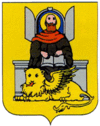Variazh
| Variazh Варяж | ||
|---|---|---|
| Village | ||
|
Panorama of Variazh with the St. Mark's Church seen in the distance. | ||
| ||
| Coordinates: UA 50°31′01″N 24°05′33″E / 50.51694°N 24.09250°ECoordinates: UA 50°31′01″N 24°05′33″E / 50.51694°N 24.09250°E | ||
| Country |
| |
| Province |
| |
| District | Sokal Raion | |
| First mentioned | 1419 | |
| Magdeburg rights | 1538 | |
| Government | ||
| • Village Head | Yuriy Horodko (NRU) | |
| Area | ||
| • Total | 2.17 km2 (0.84 sq mi) | |
| Elevation[1] | 202 m (663 ft) | |
| Population (2001) | ||
| • Total | 888 | |
| • Density | 410/km2 (1,100/sq mi) | |
| Time zone | EET (UTC+2) | |
| • Summer (DST) | EEST (UTC+3) | |
| Postal code | 80014 | |
| Area code | +380 3257 | |
| Website | http://rada.gov.ua/ | |
Variazh (Ukrainian: Варяж; Polish: Waręż) is a former city (currently a village) in the Sokal Raion (district) of Lviv Oblast (province) in western Ukraine. Its population is 888 as of the 2001 Ukrainian Census.[2] The village is located close to the border with Poland, near the Polish village of Uśmierz.[3]
The first written documents date the settlement back to in 1419 as Waręż.[3] In 1538, the settlement was granted the Magdeburg rights.[3][4] Waręż had a significant population of Jews living in the city: in 1880, there were 880 Jews; in 1900, there were 964 Jews; in 1921, there were 520 Jews. During the Holocaust, Waręż's entire Jewish population was killed.[5]
Until the Soviet invasion of Poland in 1939, Waręż was a part of the Polish Lwów Voivodeship (Sokal County) and – since 1934 – seat of the Gmina Waręż, a rural administrative district of Poland[6] (Waręż does not appear on lists of towns since at least 1931,[7][8][9] and prior to this it only had market town status (miasteczko), which was considered a rural unit in an administrative sense[10]).
During the war, the settlement became a part of the Hrubieszów County,[11] which after the war returned to the Lublin Voivodeship. During the 1951 Polish–Soviet territorial exchange, Waręż along with most of the pre-war Sokal County was transferred from the People's Republic of Poland to the Ukrainian Soviet Socialist Republic.[12] There, the settlement was renamed to Novoukrainka (Ukrainian: Новоукраїнка),[2] a name which it kept until 1989 when it was reverted to its original—albeit Ukrainian variant of the name, "Variazh."
People from Variazh
- Yaroslav Mendus, Ukrainian politician
See also
References
- ↑ "Variazh (Lviv Oblast, Sokal Raion)". weather.in.ua. Retrieved 15 February 2012.
- 1 2 "Variazh, Lviv Oblast, Sokal Raion". Regions of Ukraine and their Structure (in Ukrainian). Verkhovna Rada of Ukraine. Retrieved 15 February 2012.
- 1 2 3 "Variazh". karpaty.info (in Ukrainian). Retrieved 16 February 2012.
- ↑ "Variazh". Architectural and Natural Monuments of Ukraine (in Ukrainian). Retrieved 16 February 2012.
- ↑ "Variazh". Russian Jewish Encyclopedia (in Russian). Retrieved 16 February 2012.
- ↑ Dz. U. z 1934 r. Nr 64, poz. 554 - Rozporządzenie Ministra Spraw Wewnętrznych z dnia 14 lipca 1934 r. o podziale powiatu sokalskiego w województwie lwowskiem na gminy wiejskie
- ↑ Drugi Powszechny Spis Ludności z dnia 9 grudnia 1931 r., GUS, Warszawa, 1932
- ↑ Podział administracyjny Rzeczypospolitej Polskiej: Praca zespołowa pod redakcją prof. Stanisława Srokowskiego. Warszawa: Biblioteka Samorządowca Nr 77, 1948.
- ↑ Informator adresowy miast i gmin wiejskich Rzeczypospolitej Polskiej. Warszawa: Instytut Wydawniczy Kolumna, 1948.
- ↑ Skorowidz miejscowości Rzeczypospolitej Polskiej - Tom XIII - Województwo Lwowskie, Główny Urząd Statystyczny Rzeczypospolitej Polskiej, Warszawa 1924
- ↑ Amtliches Gemeinde- und Dorfverzeichnis fuer das GG
- ↑ Sylwester Fertacz, Krojenie mapy Polski: Bolesna granica. Alfa. Retrieved from the Internet Archive on 14 November 2011
External links
- "22 May: Belz, Uhniv, Variazh, Tartakiv" (Photogallery). Zabrama (in Ukrainian). Retrieved 20 February 2012.
